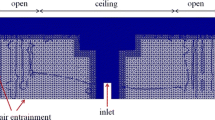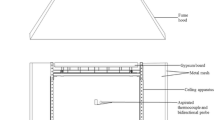Abstract
A field model code, JASMINE, has been adopted to calculate ceiling jet flows caused by plumes from unsteady fire sources in a large corridor. The idealized fast- and medium-fire energy release rates, obeying thet 2 law for fire growth, were used. The effects of vents were studied by simulating three different configurations: a centrally located vent—that is, a vent directly above the fire source; an eccentrically located vent; and no vent. The results were compared with recent large-scale experiments conducted at the Swedish National Testing and Research Institute (SP) and with results from the computer program LAVENT. Some calculated sprinkler temperatures with three different RTI values are also presented.
The present JASMINE simulations agree reasonably well with measured ceiling temperatures and velocities in large-scale tests. In general, the calculated ceiling jet temperatures are slightly overestimated and the velocities slightly underestimated. Also, the layer thicknesses calculated by JASMINE are somewhat thinner than those measured. The ceiling jet theory and present LAVENT results predict very thin layer thicknesses. However, these theories are only valid when wall effects are eliminated. From the present study it can be concluded that CFD models are generally more accurate when used to predict confined and unconfined flows.
Similar content being viewed by others
References
Alpert, R. L., “Calculation of Response Time of Ceiling-Mounted Fire Detectors,”Fire Technology, Vol. 8 (1972).
Heskestad, G. and Delichatsios, M. A.,Proceedings of the 17th International Symposium on Combustion, Pittsburgh: The Combustion Institute, Pittsburgh, 1978, p. 1113.
Delichatsios, M. A.,Journal of Fluid Mechanics Vol. 93 (1979) p. 241.
Delichatsios, M. A., “The Flow of Fire Gases Under a Beamed Ceiling,”Combustion and Flame, Vol. 43 (1981).
Koslowski, C. C., and Motevalli, V., “Behavior of a 2-Dimensional Ceiling Jet Flow: A Beamed Ceiling Configuration,”Fire Safety Science — Proceedings of the Fourth International Symposium, Ottawa, Elsevier: 1994 (to appear).
Cooper, L. Y., “Estimating the Environment and Response of Sprinkler Links in Compartment Fires with Draft Curtains and Fusible Link Actuated Ceiling Vents—Theory,”Fire Safety Journal, Vol. 16 (1990).
Hinkley, P. L., “The Effect of Vents on the Opening of the First Sprinkler,”Fire Safety Journal, Vol. 11 (1986).
Ingason, H., Olsson, S.,Interaction Between Sprinklers and Fire Vents, Swedish National Testing Institute, SP-REPORT 1992:11.
Cox, G., Kumar, S., “Field Modelling of Fire in Forced Ventilated Enclosures”,Combustion Science and Technology, Vol. 52 (1987).
Kumar, S., Gupta, A. K., and Cox, G., “Effects of Thermal Radiation on the Fluid Dynamics of Compartment Fires,”Fire Safety Science—Proceedings of the Third International Symposium, eds. G. Cox and Langford, London: Elsevier Applied Science, 1991, pp. 345–354.
Cox, G., “Some Recent Progress in the Field Modelling of Fire”,Fire Science and Technology, Eds. F. Weicheng and F. Zhuman, Heifei, China: International Academic Publishers: 1992, pp. 50–59.
Dahlberg, M.The SP Industry Calorimeter for Rate of Heat Release Measurements up to 10 MW, Swedish National Testing and Research Institute, SP-REPORT 1992:43.
NFPA 72E,Automatic Fire Detectors, 1987.
Magnussen, B. F.,The Eddy Dissipation Concept, XI Task Leaders Meeting—Energy Conservation in Combustion, IEA, 1989.
Kumar, S., Cox, G., “Radiant Heat and Surface Roughness Effects in Numerical Modelling of Tunnel Fires,”6th International Symposium on the Aerodynamics and Ventilation of Vehicle Tunnels, Durham, England: 1988.
Rodi, W.,Turbulence Effects and their Application in Hydraulics—A State of the Art Review, Federal Republic of Germany: Institut Für Hydromechanik und Sonderforschungbereich 80, University of Karlsruhe, Karlsruhe, 1980.
Motevalli, V., Marks, C. H., “Transient Characteristics of Unconfined Fire-Plume-Driven Ceiling Jets,” National Institute of Standards and Technology, NIST—GCR—90—574, 1990.
Kumar, S., Yehia, M., “Mathematical Field Modelling of Transient Ceiling Jet Characteristics in Fires,” Heat & Mass Transfer 94, Proceedings of the First ISHMT—ASME Heat & Mass Transfer Conference & 12th National Heat & Mass Transfer Conference, Bombay, India: Bhabha Atomic Research Center, 1994.
Emmons, H. W., “The Ceiling Jet in Fires,”Fire Safety Science, Proceedings of the Third International Symposium, 1991, pp. 249–260.
Heskestad, G., “The Sprinkler Response Time Index (RTI),” paper (RC81—TP—3) presented at the Technical Conference on Residential Sprinkler Systems, FMRC, Norwood, MA, 1981.
Hossain, M. S. and Rodi, M., “A Turbulence Model for Buoyant Flow and Its Application to Vertical Buoyant Jets,”Turbulent Buoyant Jets and Plumes ed. W. Rodi, New York: Pergamon Press, 1982.
Davidson, L., “Second-Order Correction of the k-ε Model to Account for Nonisotropic Effect Due to Buoyancy,”Int. J. Heat Mass Transfer, Vol. 33, pp. 2599–608.
Shabbir, A. and Taulbee, D. B., “Evaluation of Turbulence Models for Predicting Buoyant Flows”,Journal of Heat Transfer, ASME, Vol. 112 (1990), pp. 945–51.
Nam, S. and Bill, R. G., “Numerical Simulation of Thermal Plumes,”Fire Safety Journal, Vol. 21 (1993), pp. 231–256.
Bilger, R. W., “Computational Field Models in Fire Research and Engineering,”Fire Safety Science—Proceedings of the Fourth International Symposium, ed. Takashi Kashiwagi, International Association for Fire Safety Science, 1994.
Author information
Authors and Affiliations
Rights and permissions
About this article
Cite this article
Tuovinen, H. Validation of ceiling jet flows in a large corridor with vents using the CFD code JASMINE. Fire Technol 32, 25–49 (1996). https://doi.org/10.1007/BF01040756
Issue Date:
DOI: https://doi.org/10.1007/BF01040756




